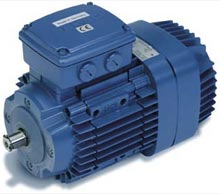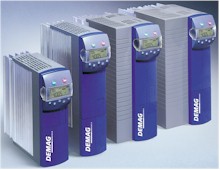 An electrical machine that converts alternating-current
(ac) electric energy to mechanical energy. Alternating-current motors
are widely used because of the general availability of ac electric power
and because they can be readily built with a variety of characteristics
and in a large range of sizes, from a few watts to many thousands of
kilowatts. They can be broadly classified into three groups—induction
motors, synchronous motors, and ac series motors:
An electrical machine that converts alternating-current
(ac) electric energy to mechanical energy. Alternating-current motors
are widely used because of the general availability of ac electric power
and because they can be readily built with a variety of characteristics
and in a large range of sizes, from a few watts to many thousands of
kilowatts. They can be broadly classified into three groups—induction
motors, synchronous motors, and ac series motors:
- Induction motors
- Single-phase
- Split-phase
- Capacitor-start
- Capacitor-run
- Split-phase
- Polyphase
- Single-phase
- Synchronous motors
- Single-phase
- Permanent-magnet (PM)
- Reluctance
- Hysteresis
- Polyphase
- Wound-field
- Permanent-magnet (PM)
- Reluctance
- Single-phase
- AC series or universal motors (single-phase)
The most common type of ac motor, both in total number and in total power, is the induction motor. In larger sizes these machines employ a polyphase stator winding, which creates a rotating magnetic field when supplied with polyphase ac power. The speed of rotation depends upon the frequency of the supply and the number of magnetic poles created by the winding; thus, only a discrete number of speeds are possible with a fixed-frequency supply.
 Currents
are induced in the closed coils of the rotor for any rotor speed different
from the speed of the rotating field. The difference in speed is called
the slip speed, and efficient energy conversion occurs only when the
slip speed is small. These machines are, therefore, nearly constant-speed
machines when operated from a constant-frequency supply. They are, however,
routinely started from zero speed and accelerated through the inefficient
high-slip-speed region to reach operating speed.
Currents
are induced in the closed coils of the rotor for any rotor speed different
from the speed of the rotating field. The difference in speed is called
the slip speed, and efficient energy conversion occurs only when the
slip speed is small. These machines are, therefore, nearly constant-speed
machines when operated from a constant-frequency supply. They are, however,
routinely started from zero speed and accelerated through the inefficient
high-slip-speed region to reach operating speed.
In contrast to an induction motor, the rotor of a synchronous motor runs exactly at the rotating field speed and there are no induced rotor currents. Torque is produced by the interaction of the rotating field with a direct-current (dc) field created by injected dc rotor current or permanent magnets, or with a rotor magnetic structure that has an easy direction for magnetization (in the reluctance motor). Since for any frequency of excitation there is only one speed for synchronous torque, synchronous machines have no starting torque unless the frequency is variable. When the motor is used in fixed-frequency applications, an induction-machine winding is also placed on the rotor to allow starting as an induction motor and running as a synchronous motor.
AMAZON multi-meters discounts AMAZON oscilloscope discounts
A dc motor with the armature and field windings in series will run on ac since both magnetic fields reverse when the current re verses. Since these machines run on ac or dc, they are commonly called universal motors. The speed can be controlled by varying the voltage, and these machines are therefore widely used in small sizes for domestic appliances that require speed control or higher speeds than can be attained with 60-Hz induction motors.
 We
have created a comprehensive information tutorial on AC
Inverters (aka
AC drives). Click here to
jump to that section.
We
have created a comprehensive information tutorial on AC
Inverters (aka
AC drives). Click here to
jump to that section.